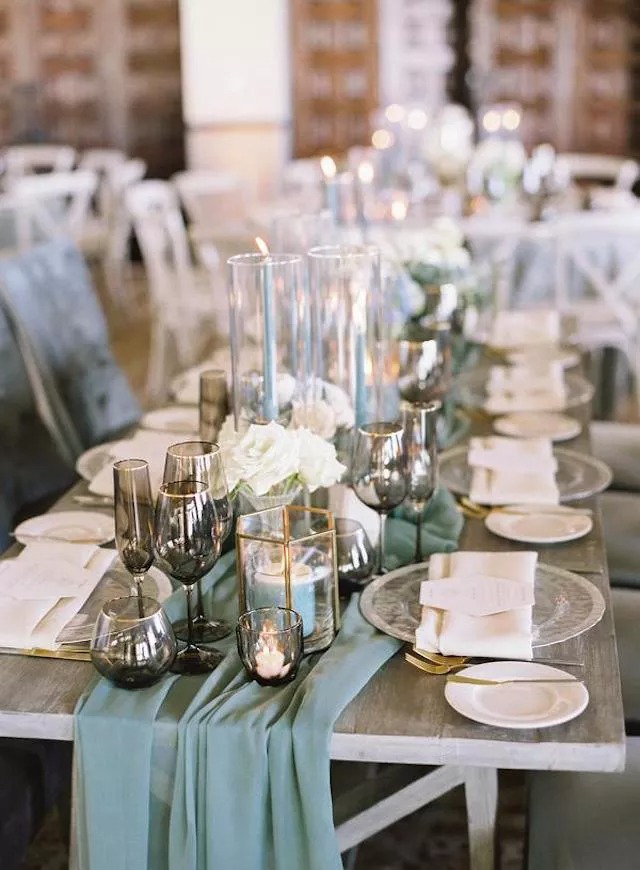What Is a Charger Plate?
A charger plate is a large, decorative base setting on top of which other dinnerware is placed during formal occasions such as catered events, weddings, upscale parties, banquets, or in fine dining restaurants. Also known as service plates, under plates, or chop plates, charger plates are merely decorative and are not meant to come in direct contact with food. Charger plates provide an elegant way to serve multiple course meals, where each course is served in a separate bowl or plate and placed on top of the charger.
Charger plates are available in a variety of colors, materials, lengths/diameters, and shapes for you to choose from to match the decor, mood, and style of your particular event. Chargers are used in multiple-course meals as an elegant way to serve salad plates, soup bowls, and main dinner entrees to create unique presentations for guests.

How to Use Charger Plates
If you’re new to the concept of charger plates, you may like some clarification on how to correctly use one. To properly use a charger plate, follow the instructions below:
- Find a plate: Choose a charger plate that will help complement the decor of your dining table and add visual interest to your event’s overall feel. Take into consideration the type of plates, bowls, beverage glasses, flatware, serving platters, and linens you plan to use, and then choose a charger that will balance those styles. Don’t forget about the tablecloth, fabric overlays, floral arrangements, and centerpieces that will be placed directly beside the charger plates.
- Set the table: Place a charger at each guest’s corresponding place setting. Set it on top of the tablecloth or placemat, in between the arranged flatware, and below the beverage glasses. Chargers should be two feet from one another to give guests enough elbow room.
- Coordinate table accessories: Align menu cards, napkins with napkin rings, or name cards in the middle of the charger plate for use before the dinner service.
- Serve your guests: Soup bowls, salad plates, and dinner entrees are placed directly on top of the charger when guests are ready to be served.
- Clean your charger plate: After each course, charger plates should be wiped clean or replaced to maintain the purity of the table.
Charger Plate Materials
WebstaurantStore features charger plates in a variety of materials, including the ones listed below. You may use the links directly below the images to navigate to our selection of chargers in that particular material.
What Is a Charger Plate Used For?
Charger plates have many practical purposes, besides the fact that they provide elegance and enhance the table decor in a fine dining establishment. Not only do they anchor the dining table, create ambiance, and are aesthetically pleasing to guests, but chargers also protect the table and tablecloth from becoming dirty during service. Charger plates can catch pieces of food and prevent spills and messes that would otherwise stain the tablecloth or flow onto the table. Chargers also help to retain the heat in dinnerware since they are placed directly underneath plates and bowls.
Common Charger Plate Features
When it comes to picking the right charger plate for your dining area, there are a few common features to consider. Ask yourself the following questions to determine whether the charger plate you’ve chosen is right for you:
- Is it dishwasher safe? Opt for dishwasher-safe charger plates for faster clean-up at the end of service.
- Is it environmentally friendly? Choosing eco-friendly charger plates made from sustainable alternative allow you to ensure your establishment takes proper steps to have a positive effect on the environment.
- What shape are they? Charger plates are available in a variety of shapes, including square and round, allowing you to find the shape that best fits your table.
Charger Plate Etiquette
Since charger plates are used as decorative table pieces and are traditionally used in formal settings, there are certain formalities that you should adhere to as you use them. Follow these specific etiquette rules when using charger plates at your upscale catered event, wedding, fine dining restaurant, or dinner party:
- Prepare early: Charger plates should be dressed and ready when guests arrive.
- Wait for guests to finish eating: Chargers are always removed from the table after all guests are finished eating the main entree. Chargers should then be taken away with the dinner plate still on top, as this clears the table and leaves it ready for dessert to be served.
- Know when to take charger plates away: Chargers can be removed once all guests are seated, or they may remain on the table throughout the entire length of the meal.
- Follow proper placement guidelines: Place charger plates one inch away from the bottom edge of the table to create perfect alignment.
- Avoid direct contact: Never serve food directly on top of a charger plate, unless it is coated in a food-safe material.
Other Charger Plate Uses
The elegance of a charger plate does not need to be restricted to just holding a dinner plate. Here are some additional uses for your chargers:
- Use charger plates as a tray or platter to pass around small appetizers or desserts, but make sure to place a doily or linen napkin on top of the charger when coming in contact with food.
- Group pillar candles together to create an elegant centerpiece.
- Set floral centerpieces on top of chargers to create a colorful base.
Whether you’re hosting a formal get-together, catering a wedding, or planning a reunion, charger plates are an important part of bringing a table together. No matter what formal event you’re planning, you can use the information above to ensure you adhere to the proper use, etiquette, and presentation of charger plates.
If you want to know more about outdoor weddings, please click this: How banquet setup can make or break your events
